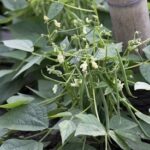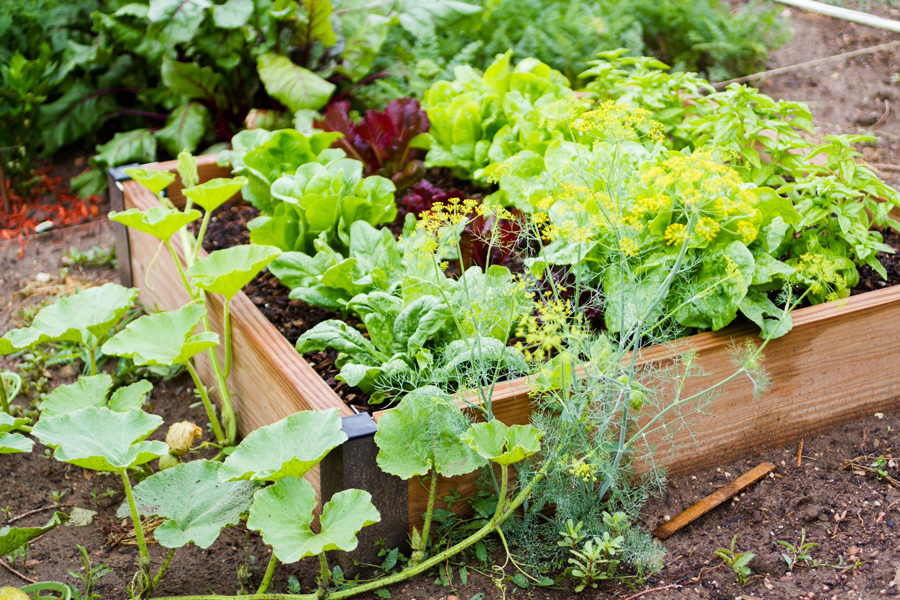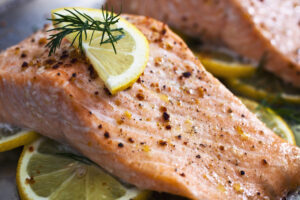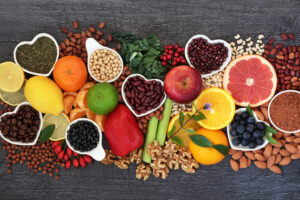Gardening is a great spring activity that gets you outdoors and increases your access to heathly foods. Many people find gardening to be relaxing, rewarding, and a great creative outlet. It’s always fun to try something new every year. Whether you are already a gardener or would like to get started, you may find something helpful in the article below. Happy Spring!
-Beth & Mary Beth
GROWING VEGETABLES IN SMALL SPACES
Every square inch matters in a small vegetable garden. Here are practical tips for increasing your bounty.
By Anne Balogh
Is your garden bed a twin size versus a king? Or maybe you have no land at all, and only a tiny balcony or patio. No problem. As long as you can find a sunny location, either on the ground or in mid-air, you can satisfy your appetite for freshly picked produce.
Even in a small 4-foot by 4-foot bed like this, you can grow plenty of vegetables.
“Almost everyone has access to more space than they realize. It just takes a little creative thinking to see it,” says Andrea Bellamy, in her book Small-Space Vegetable Gardens. A rooftop, alleyway, front porch, and even a fire escape are all viable spots for growing vegetables. The keys to success are careful planning and making the most of what you’ve got.
MAXIMIZE SPACE
Think outside the plot
If growing in the ground is not an option due to space limitations, poor soil, or lack of sun, containers and raised beds are great alternatives. When growing edibles in pots, choose patio or dwarf varieties and shallow-rooted plants such as lettuce, radishes, garlic, and leeks. For containers, you can use almost anything that holds soil — from plastic grow bags to old metal wash buckets — as long as you provide good drainage, says Bellamy. Remember that container plants need more water than those in the ground, it’s best not to let them completely dry out. Also be sure to fertilize your containers during the growing season, using an organic fertilizer such as liquid kelp or fish (follow the directions on the label).

Raised garden beds are a great option if you have a level foundation on which to build them. Compared with in-ground beds, they offer the advantages of easier access, better drainage, and faster warming of the soil in the spring. “Digging and tilling beds in the ground is great, but it can take a few years to build up really good soil. Raised beds filled with a mix of good soil and compost will get beginners off to a good start. Even a bed as small as 4×4 feet will hold a lot of vegetables and be manageable,” says Susie Middleton, an avid kitchen gardener and the author of numerous cookbooks including her latest, Simple Green Suppers: A Fresh Strategy for One-Dish Vegetarian Meals (available at sixburnersue.com).
Go Vertical
If you want to plant vining vegetables such as pole beans, cucumbers, and squash, give them something for their tendrils to grab on to like a trellis, fence, or netting. Gardening up not only saves space, it also creates structure and visual interest. “I like to plant cucumbers against the garden fence or up a trellis to save space; each plant only needs about a foot of space in the garden,” says Middleton.
Trellises come in countless shapes, styles, and materials. But you can easily make your own using simple bamboo poles secured at the top to form a tepee shape. If you have space on a sunny exterior wall, Bellamy recommends growing herbs and shallow-rooted vegetables in wall-mounted planters or modular green wall systems. “A wide variety of wall-mounted planters are available, from simple, narrow plastic or wooden containers to self-watering polypropylene pockets that can be used en masse for a green wall effect,” she says.

Create an Edible Landscape
Edible landscaping is a creative and attractive solution to growing vegetables in a front yard or other conspicuous location. Try mixing ornamental vegetables and herbs into the perennial garden or tuck them into containers. They can also be attractive on their own, especially if you combine various colors and textures.
CHOOSE THE RIGHT PLANTS
Be Productive
When you only have limited garden space to work with, choose plants that will give you big yields in a small area. Many vegetables and herbs have compact cultivars that are container friendly and ideal for small gardens. (See our list of Ten Great Space-Saving Edibles).
Make Priorities
In a small garden, you have scant room to experiment or plant crops that will go to waste. Make priorities by planting what you love, what’s unique, and what will thrive. Also plant what tastes best freshly picked. “Lettuce meets all my qualifications for a perfect crop,” says Bellamy. “I use a lot of it, and it tastes best straight from the garden. It’s also fast growing, attractive, space efficient, and easy to grow.”
Come Back for More
Many types of garden greens will feed you throughout the growing season if you harvest them continuously. These “cut-and-come” vegetables keep on giving by sprouting new leaves when the outer leaves are snipped off. Examples include loose-leaf lettuce, chard, kale, collard greens, mesclun, and escarole. “Lettuce varieties like ‘Salad Bowl’ and ‘Red Salad Bowl’ are great for containers or any small space. Instead of letting the lettuce head up, you can pick the outer leaves continuously,” says Middleton.
TEN GREAT SPACE-SAVING EDIBLES

‘Patio Baby’ Eggplant
This prolific dwarf eggplant produces egg-shaped, 2-to 3-inch purple-black fruits that lack the bitterness of larger varieties. One plant fits comfortably in an 18-inch container, with no staking required. Each plant produces as many as 50 baby eggplants that can be harvested throughout the season. See recipe below for “eggplant balls”.

‘Bright Lights’ Chard
This attractive cut-and-comer features a colorful mix of yellow, ruby red, and white stalks. It’s also cold-hardy and tolerates light shade.

‘Red Russian’ Kale
With lovely saw-toothed gray-green leaves and red veining, this delicious kale is pretty enough to plant among flowers in containers and garden beds. It’s well-suited for small spaces because it can be seeded thickly and then cut as baby greens when only a few inches high.

‘Sugar Ann’ Snap Pea
While most peas need a trellis to climb, there are dwarf varieties, such as ‘Sugar Ann’, that grow no taller than 24 inches and don’t need staking. “I love growing dwarf snap peas around the edge of containers. They trail over the side and look very pretty when they bloom,” says Bellamy.

‘Spicy Globe’ Basil
If you often have a craving for fresh pesto, this rounded, compact basil will give you a vigorous crop of tasty leaves ready for picking all summer long. After the plant is established, harvesting frequently actually improves production. Simply pinch back the plant to maintain its mounded shape and to encourage new branch development.

‘Tumbler’ Tomato
As the name implies, this hybrid bush tomato is bred for hanging baskets and containers. Each plant produces up to 6 pounds of bright-red cherry tomatoes over an inch in diameter. You can also enjoy your harvest early, because the fruit reaches maturity in only 50 days

‘Astia’ Zucchini
Zucchini has a reputation for taking over the garden, with its rambling vines that are almost impossible to tame. ‘Astia’ is a French bush variety bred specifically for containers and small gardens, growing only 2 to 3 feet tall and wide. The plant is not only an abundant producer, it’s also highly ornamental with large silvery-green, indented leaves.

‘French Breakfast’ Radish
Short-rooted radishes, such as this heirloom variety, can be grown in containers only 6 inches deep. ‘French Breakfast’ has 1 ¾-inch oblong roots that are crisp and mildly spicy. The radishes reach maturity in just 25 days, making this a great crop for succession planting.

‘Mascotte’ Bush Bean
Both pole beans and bush beans can be grown in containers and small gardens, but pole beans require vertical support, while bush varieties, such as ‘Mascotte’, have a sturdy, upright form that needs no staking. ‘Mascotte’ is a French-style green bean that grows to a height of only 18 inches. Despite its compact size, it’s a heavy producer, yielding an abundance of tender 6-inch-long stringless beans that sit on the top of the foliage for easier picking.

‘Ambition Shallot’
Why pay a premium price at the grocery store when it’s so convenient to grow your own? Shallots require far less space to grown than other members of the onion family and have a more delicate flavor with a hint of garlic. ‘Ambition’ is a high-yielding variety that produce large, long-keeping bulbs and is easy to grow from seed.
WHERE TO BUY EDIBLES
If you can’t find the edibles you want at a local nursery, try these online sources:
Johnny’s Selected Seeds
1-877-564-6697
Burpee
1-800-888-1447
Renee’s Garden
1-888-880-7228
Baker Creek Heirloom Seeds
1-417-924-8917
Hudson Valley Seed Company
1-845-204-8769
PLAN FOR BETTER YIELDS
Keep ‘em Coming
Keep your small garden productive throughout the growing season by planting a series of crops in succession in a garden bed or container, starting with cool-season, early-maturing crops in the spring followed by mid-season and late-summer vegetables that will last until fall. “The idea of succession planting is to not let valuable garden space sit idle, and to be ready to plant something new whenever a space opens up,” says Bellamy. The same technique can also be used to extend the growing season for one type of crop, particularly fast-maturing edibles such as radishes and beans. By planting them in two- to three-week intervals they will reach maturity at different times.
Choose Good Companions
Interplanting is similar in concept to succession planting, except that you maximize yields by pairing up different crops that are good companions and grow at different rates. For example, you can plant sugar snap peas in early spring and plant pole beans among them. By the time the peas are spent, the beans will be ready to take their place.
Succession planting and companion planting and great ways to increase your yield when growing vegetables in a raised bed—the only downside is that they won’t really work in containers.
Stretch the Growing Season
Vegetable gardens aren’t just for the warm-weather months of May through September. There are many cool-season crops that will thrive in the ground or in containers well into fall, and some will even survive a nip of frost. See these suggestions for no-fail fall crops.






